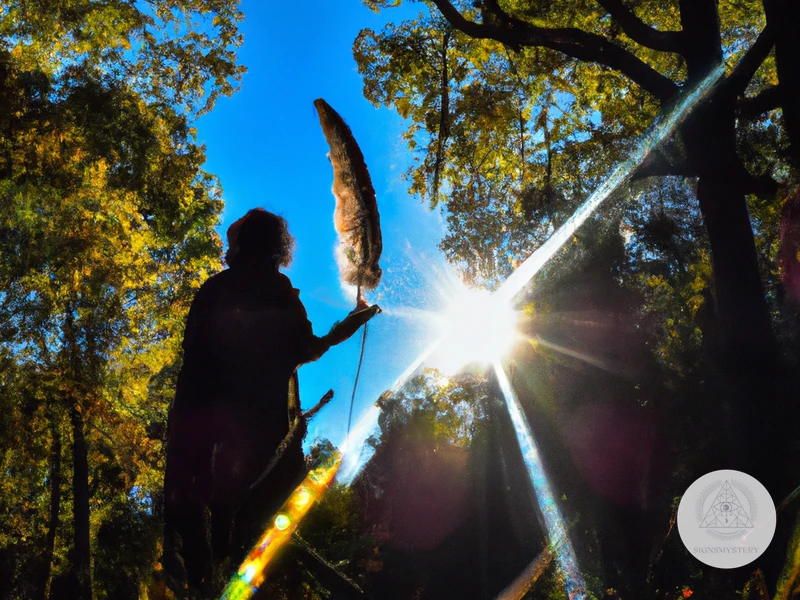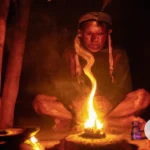Shamanism is an ancient practice that has been used for centuries to address trauma and provide healing to individuals. Trauma, on the other hand, is a common experience that most people encounter at some point in their lives. Although there are different approaches to healing trauma, shamanic healing techniques have proven to be effective in restoring inner peace and promoting overall well-being. In this comprehensive guide, we will explore the various shamanic techniques available for healing trauma and PTSD, how to choose the right shamanic practitioner, the benefits of shamanic healing for trauma and PTSD, and precautions to take when using shamanic techniques for healing. Whether you are new to shamanism or seeking alternative approaches to traditional treatment, this guide is designed to help you make the right decision for your individual needs. So, let’s dive into the world of shamanic healing techniques and discover the power they hold.
Understanding Shamanism and Trauma

Shamanism has been used for centuries to help individuals heal from physical, emotional, and spiritual ailments. Trauma, on the other hand, can leave lasting effects on an individual’s mind and body. By understanding the principles of shamanism and how it can be used to help heal trauma, individuals can find inner peace and move forward from their past experiences. Shamanism believes that everything in the physical world is connected to the spiritual world, and that trauma can create disconnection within oneself. Techniques such as grounding and centering, journeying, soul retrieval, ceremony and ritual, and herbal medicine can be used to help individuals reconnect with their inner selves and find healing. Shamanic journeying can help individuals access their unconscious mind and bring to light repressed emotions and memories, while working with spirit guides can provide support and guidance throughout the healing journey. It’s important to note that shamanic healing should not be the only form of treatment, but rather can be used in conjunction with other therapies to provide a holistic approach to healing from trauma.
What is Shamanism?
Shamanism is an ancient spiritual practice that originated in various indigenous cultures around the world. Many cultures have their own version of shamanism, but the basic principles remain the same. Shamans are spiritual leaders who act as intermediaries between the physical world and the spiritual realm. They believe that everything in the universe is interconnected, and that humans can communicate with the spirit world to gain insight and guidance.
Shamanic practices involve using various techniques such as dream analysis, chanting, dancing, and drumming to enter a trance-like state, where the shaman can communicate with spirits. Shamans use their abilities to perform spiritual healing, and some shamans are known to have the ability to communicate with the dead or to see into the future. Some shamanic traditions also involve the use of sacred plants, such as ayahuasca or psilocybin mushrooms, to induce altered states of consciousness.
Shamanism is widely recognized as a legitimate form of spiritual practice and has been studied extensively by psychologists and anthropologists. It has been incorporated into different fields such as addiction recovery, inner child healing, and grief counseling. In recent years, there has been an increased interest in shamanic practices and their potential benefits for individuals who have experienced trauma or PTSD. There are many spiritual guides and shamans who offer shamanic healing for trauma and PTSD.
What is Trauma?
Trauma is a psychological, emotional, or physical response to a deeply distressing or disturbing event or series of events. Trauma can arise from a variety of experiences, including violent or abusive relationships, natural disasters, accidents, and military combat. It can also be caused by non-violent events such as being bullied or experiencing discrimination. Trauma can leave people feeling helpless, vulnerable, and fearful, which in turn can lead to a range of emotional problems such as anxiety, depression, and PTSD.
Traumatic experiences can sometimes be so overwhelming that they cause people to dissociate, or disconnect from themselves and the present moment. This can result in feelings of numbness, detachment, and a sense of being cut off from the world around them.
Understanding trauma is an important part of the healing process. It helps individuals to recognize their own symptoms and to develop an awareness of how their past experiences may be impacting their present lives. By acknowledging and accepting the reality of the trauma, individuals can begin the process of healing and recovery.
Shamanic techniques for healing trauma aim to address trauma at its root, helping individuals to re-establish a sense of connection to themselves, others, and the world around them. Through techniques like journeying and soul retrieval, shamanic practitioners work with individuals to locate and release trapped energies, emotions, and memories, allowing them to integrate their traumatic experiences in a way that promotes healing and growth. To learn more about shamanism and the unconscious mind, visit here. Also, you can find an overview of transpersonal psychology and shamanism at this link.
Shamanic Techniques for Healing Trauma and PTSD
Shamanic techniques have been used for centuries to heal trauma and PTSD. Grounding and centering is a technique that involves connecting to the earth and finding inner balance. This can be done through meditation or physical movements such as yoga. Journeying is a technique that involves entering an altered state of consciousness to gain insight and healing. This can be done through drumming, visualization, or using entheogens under the guidance of a trained shaman. Soul retrieval is a technique that involves reclaiming the fragmented parts of oneself that were lost during traumatic events. Ceremony and ritual can be used to create a safe and sacred space for healing to occur. Finally, herbal medicine can be used to support the body’s natural healing processes. These techniques can be powerful tools in healing trauma and PTSD, but it’s important to seek out a trained shamanic practitioner and take necessary precautions.
Grounding and Centering
Grounding and centering are foundational practices in shamanism that can help individuals with trauma and PTSD reconnect with the present moment and find inner peace. Grounding involves connecting with the earth and feeling a sense of stability and rootedness, while centering involves finding balance and calm within oneself.
Grounding Techniques:
- Barefoot Walking: Take off your shoes and walk barefoot on the ground, feeling the texture of the earth beneath your feet. Focus on the sensations in your body and the connection you feel with the earth.
- Tree Hugging: Find a tree and wrap your arms around its trunk. Imagine yourself as an extension of the tree’s roots, grounded and stable.
- Meditation: Sit in a comfortable position and focus on your breath. Imagine roots growing from your feet into the earth, anchoring you in place.
Centering Techniques:
- Breathwork: Take deep, intentional breaths and focus on the sensations in your body. Visualize yourself becoming more centered and balanced with each breath.
- Body Scan: Close your eyes and mentally scan your body from head to toe, noticing any areas of tension or discomfort. Breathe into those areas and release the tension.
- Affirmations: Repeat positive affirmations to yourself, such as “I am grounded and centered” or “I am at peace.”
Practicing grounding and centering can help individuals with trauma and PTSD find a sense of calm and stability, which is crucial for healing and growth. These techniques can be practiced daily or in moments of stress or anxiety to help bring oneself back to the present moment.
Journeying
Journeying is a crucial Shamanic technique that can help individuals deal with the effects of trauma and PTSD. It involves entering an altered state of consciousness to connect with one’s inner spirit guides and access deeper levels of self-awareness.
During a journey, a Shamanic practitioner will often use rhythmic drumming, chanting, or other sensory cues to help the individual reach a trance-like state. At this point, the individual can access their subconscious mind and communicate with their spirit guides to gain insight into the root causes of their trauma and the steps needed to heal.
The following are common steps involved in journeying:
| Step | Description |
| 1 | Setting the intention: Before beginning a journey, it is essential to set a clear intention for what you want to achieve, such as gaining insight into the source of your trauma or receiving guidance on the next steps in your healing journey. |
| 2 | Entering a trance-like state: This involves using rhythmic drumming, chanting, or other sensory cues to help the individual enter an altered state of consciousness. |
| 3 | Meeting your spirit guides: Once in the trance state, the individual can communicate with their spirit guides to receive guidance, support, and insight into their trauma and steps needed to heal. |
| 4 | Journeying back: After receiving guidance from their spirit guides, the individual will journey back to the physical world with a newfound understanding of their trauma and the necessary steps for healing. |
Journeying can be a powerful tool for healing trauma and PTSD, as it allows individuals to access their subconscious mind and gain insight into the root causes of their pain. However, it is essential to work with a trained Shamanic practitioner to ensure that the journey is safe and that proper precautions are taken to avoid re-traumatization.
Journeying is an effective Shamanic technique that can help individuals deal with the effects of trauma and PTSD. It involves setting an intention, entering an altered state of consciousness, meeting with spirit guides, and journeying back to the physical world with newfound insight. Working with a trained Shamanic practitioner is crucial to ensure a safe journey and avoid re-traumatization.
Soul Retrieval
is a shamanic technique used to heal past traumas and PTSD by identifying and restoring lost parts of the soul. According to shamanic beliefs, a traumatic experience can cause a person’s soul to fragment and separate, leading to feelings of disconnection, detachment, and soul loss. This technique is considered one of the most powerful methods of shamanic healing and can have a profound impact on an individual’s overall well-being.
During the soul retrieval process, a shamanic practitioner will journey into the spiritual realm to locate and communicate with the lost parts of the individual’s soul. This may involve connecting with spirit guides or allies who can help guide the practitioner to the specific area in which the lost soul fragments reside.
Once the lost fragments have been located, the practitioner will gently guide them back into the individual’s soul, helping to restore wholeness and balance to their energy field. This may involve the use of various healing techniques, such as singing, drumming, smudging, or chanting.
It is important to note that soul retrieval may involve facing and processing difficult emotions and memories that have been buried deep within the psyche. However, the process can also provide a sense of closure, understanding, and empowerment, helping to promote inner peace and healing.
Here are some common benefits of soul retrieval:
- Increased sense of wholeness and connection to self
- Improved mental, emotional, and physical well-being
- Decreased feelings of anxiety, depression, and dissociation
- Greater sense of purpose and direction in life
- Improved relationships and ability to connect with others
If you are considering a soul retrieval session, it is important to find a qualified and experienced shamanic practitioner who can guide you through the process with care and sensitivity. It is also important to approach the process with an open mind and heart, and to be willing to face any unresolved emotions or memories that may arise.
Soul retrieval can be a powerful tool for healing from past trauma and PTSD, helping to promote a greater sense of well-being and inner peace.
Ceremony and Ritual
Ceremony and ritual are core components of shamanic healing for trauma and PTSD. These practices involve the use of symbolism, music, and movement to create a sacred space that facilitates healing and transformation.
The Importance of Ceremony and Ritual
Ceremonies and rituals can help individuals experiencing trauma and PTSD to access deeper layers of their psyche. These practices can create a sense of safety and trust, allowing the individual to release their pain and connect with their inner wisdom. Ceremony and ritual can help individuals to connect with their ancestors, spirit guides, and other forms of spiritual support.
Types of Ceremonies and Rituals
Shamanic healing ceremonies and rituals vary depending on the culture, tradition, and beliefs of the shamanic practitioner. However, some of the most common ceremonies and rituals include:
| Vision Quests | A vision quest is a practice used to obtain guidance and clarity from spirit guides. It involves fasting and spending time alone in nature. |
| Fire Ceremonies | A fire ceremony is a ritual that involves the burning of sacred herbs and offerings to release negative energy and invoke spiritual support. |
| Drum Circles | A drum circle is a ritual that involves the use of rhythm and sound to facilitate healing and induce altered states of consciousness. |
| Sweat Lodge Ceremonies | A sweat lodge ceremony is a traditional Native American ritual that involves a steam bath in a dome-shaped structure. It is used to purify the body, mind, and spirit. |
| Despacho Ceremonies | A despacho ceremony is a ritual from the Andean tradition that involves the creation of an offering bundle made of natural elements such as flowers, seeds, and leaves. It is used to express gratitude, release negative energy, and receive blessings. |
Tips for Participating in Ceremonies and Rituals
To get the most out of ceremony and ritual, it is essential to approach them with an open mind and heart. Here are some tips for participating in these practices:
- Set Intentions: Before the ceremony or ritual, take time to reflect on your intentions for healing and transformation.
- Follow the Guidelines: Follow the instructions of the shamanic practitioner and respect the sacred space and other participants.
- Stay Present: Avoid distractions and stay focused on the present moment. Allow yourself to feel your emotions and connect with your inner experience.
- Express Gratitude: After the ceremony or ritual, express gratitude to the spiritual support, the shamanic practitioner, and the other participants.
Ceremony and ritual can be powerful tools for healing trauma and PTSD. These practices allow individuals to connect with their inner wisdom and spiritual support, release negative energy, and promote transformation. By approaching these practices with openness and respect, individuals can experience profound healing and growth.
Herbal Medicine
Herbal medicine has been used for centuries in various cultures as a form of healing. In shamanic practices, plants and herbs are believed to have spiritual qualities that can aid in healing, especially in cases of trauma and PTSD. Different plants are believed to have different healing properties and can be used in various ways, including as teas, tinctures, or even smoked.
One plant commonly used in shamanic herbal medicine is Ayahuasca, a psychoactive brew made from the Banisteriopsis caapi vine and other plant ingredients. Ayahuasca is known for its powerful effects on the mind and is often used to create a shamanic journey or vision quest. It is believed that Ayahuasca can help individuals confront and process repressed emotions and traumas, ultimately providing a sense of healing and inner peace.
Another plant commonly used in shamanic herbal medicine is Cannabis. While cannabis is often thought of simply as a recreational drug, it has been used for medicinal and spiritual purposes for centuries. Cannabis is believed to have a calming effect on the mind and can be used to reduce anxiety and promote relaxation. It can also be used to enhance spiritual practices and aid in meditation.
Other commonly used plants in shamanic herbal medicine include Lavender, Chamomile, and Valerian root, which are all known for their calming and soothing properties. These plants can be used to promote relaxation and aid in sleep, which is especially important for individuals dealing with trauma or PTSD.
It’s important to note that while herbal medicine can be a powerful tool in shamanic healing, it should always be used under the guidance of a qualified practitioner. Improper use of plants or herbs can have negative side effects and may even be dangerous. It’s crucial to consult with a shamanic practitioner who is experienced in herbal medicine and can guide individuals in safely using plants for healing purposes.
How to Choose the Right Shamanic Practitioner

Choosing the right shamanic practitioner is crucial for successful healing and transformation. Qualities to look for include experience, training, certification, and good reputation. The practitioner should also have a deep spiritual connection and demonstrate compassion, empathy, and ethical behavior. It’s important to ask questions about their approach, methods, and how they will work with you. It’s recommended to choose a practitioner who specializes in trauma and PTSD, as well as someone who makes you feel comfortable and safe. Trust your intuition and take your time to find the right person to guide you on your healing journey.
Qualities to Look For
When choosing a shamanic practitioner for healing trauma and PTSD, there are certain qualities to look for that can help ensure a positive and effective experience. Here are some key qualities to consider:
| Qualities to Look For | Explanations |
|---|---|
| Experience | Look for a practitioner with a significant amount of experience in working with trauma and PTSD. They should have a deep understanding of shamanic techniques and how to apply them in a therapeutic setting. |
| Empathy | A shamanic practitioner for trauma and PTSD should have a high level of empathy and be able to understand and connect with the client’s emotional and psychological needs. They should create a safe and compassionate environment that allows the client to feel comfortable and understood. |
| Integrity | Integrity is essentialSubscribe to Our NewsletterSign up to receive the latest news and updates. |
| Intuition | Shamanic healing involves tapping into the practitioner’s intuition and inner guidance, as well as the client’s energy field and spiritual essence. A good practitioner should have a highly developed intuition and be able to sense the client’s needs on a deep level. |
| Continued professional development | The shamanic practitioner should stay up-to-date with the latest research and developments in the field of shamanic healing. They should take part in continued professional development programs to enhance their knowledge and skills, and demonstrate a commitment to ongoing self-improvement. |
When speaking with a potential shamanic practitioner, it’s essential to ask about their qualifications, experience, and approach to treatment. Don’t be afraid to ask for references and read reviews from previous clients. Choosing the right practitioner for your needs is an important decision that can have a significant impact on your healing journey. Keep in mind the importance of qualities such as experience, empathy, integrity, and intuition when making your choice.
Questions to Ask
When looking for a Shamanic Practitioner to help you heal your trauma and PTSD, asking the right questions can make all the difference in your experience. Here are some questions to consider asking before choosing a practitioner:
- What training and experience do you have? – It’s important to know a practitioner’s qualifications. Ask about their training, how long they have been practicing, and if they have experience specifically with trauma and PTSD.
- What methods do you use in your practice? – Different practitioners may use different techniques, so find out if their methods align with what you are looking for.
- How do you ensure a safe and comfortable environment? – Trauma survivors need to feel safe in the environment where treatment is taking place. Ask how the practitioner ensures a safe and welcoming space.
- What is your philosophy on Shamanic healing? – Each practitioner may have a different philosophy on Shamanic healing. Make sure their ideas align with your own before committing to their services.
- What is your process for preparing for a healing session? – It’s important to know what to expect before a healing session. Find out how the practitioner will prepare you for the experience and how they ensure you are ready for the healing work.
- How do you follow up after a healing session? – Many practitioners will follow up after a healing session to check-in and see how the patient is feeling. Ask if the practitioner offers these kinds of follow-up services.
Remember, finding the right Shamanic Practitioner is important for a successful healing experience. Don’t be afraid to ask questions and seek out a practitioner who aligns with your needs and values.
Combining Shamanic Healing with Other Therapies
Combining shamanic healing with other therapies can often provide a more holistic approach to healing trauma and PTSD. Shamanic techniques can be combined with other healing modalities such as psychotherapy, yoga, acupuncture, and meditation. It is important to work with a practitioner who is open to integrating different healing methods and can tailor their approach to your unique needs.
Some of the benefits of combining shamanic healing with other modalities include:
- Increased sense of calm and relaxation
- Greater self-awareness and insight
- Enhanced emotional regulation
- Improved physical health
When considering combining shamanic healing with other therapies, it is important to keep in mind that each modality may have different goals and approaches. It is important to communicate with all practitioners involved and ensure they are aware of each other’s techniques and goals for your healing.
For example, if you are also seeing a psychotherapist, they may have specific goals for the work you are doing together that may differ from the goals of shamanic healing. By communicating openly with both practitioners, you can ensure that your treatment is complementary and not conflicting.
Here are some examples of how shamanic healing can be combined with other modalities:
| Modality | How it can be combined with shamanic healing |
|---|---|
| Psychotherapy | Shamanic journeying can be integrated into a psychotherapy session to facilitate greater insight and emotional release. |
| Yoga | Shamanic drumming or chanting can be incorporated into a yoga practice to deepen the meditative state and promote relaxation. |
| Acupuncture | Shamanic healing can be used to address underlying emotional or spiritual issues that may be contributing to physical symptoms. |
| Meditation | Shamanic journeying can be used as a form of guided meditation to enhance visualization and promote inner healing. |
By integrating shamanic healing with other modalities, you can create a more comprehensive and effective approach to healing trauma and PTSD. Just be sure to communicate openly with all practitioners involved and ensure that their techniques are complementary.
Precautions to Take When Using Shamanic Techniques for Healing Trauma and PTSD

When using shamanic techniques for healing trauma and PTSD, it is important to take certain precautions to ensure safety and effectiveness. Here are some things to keep in mind:
Acknowledge Limitations: Shamanic healing can be powerful, but it is not a substitute for professional medical or psychological treatment. If you are currently undergoing treatment for trauma or PTSD, you should not replace it with shamanic healing.
Choose a Qualified Practitioner: Look for a practitioner who has undergone training and certification in shamanic healing. Do not work with someone who does not have the proper qualifications, as this can be dangerous.
Consider Your Comfort: Before beginning any shamanic journey or ceremony, take the time to ensure that you are in a safe and comfortable environment. This can help you to relax and focus on the healing process.
Be Honest: When working with a shamanic practitioner, be honest about your past traumas and current symptoms. This can help them to tailor their techniques to your specific needs.
Set Intentions: Before beginning any shamanic work, set clear intentions for what you hope to achieve. This can help to guide the process and ensure that you are working towards your desired outcome.
Stay Grounded: Shamanic healing can be intense and emotional. It is important to stay grounded and centered throughout the process. This can help you to avoid becoming overwhelmed or disoriented.
Take Time to Integrate: After a shamanic healing session, it is important to take the time to integrate the experience. This can involve journaling, meditating, or simply spending time in nature.
Shamanic healing can be a powerful tool for healing trauma and PTSD. However, it is important to take precautions to ensure safety and effectiveness. By choosing a qualified practitioner, staying grounded, and being honest about your needs, you can make the most out of this healing practice.
Benefits of Shamanic Healing for Trauma and PTSD
The benefits of shamanic healing for trauma and PTSD are numerous and can positively impact all aspects of a person’s life. Shamanic healing works to restore connections with the self, others, and the natural world, and in doing so can promote a sense of inner peace, empowerment, and resilience.
1. Release of Trauma and Negative Emotions: Shamanic healing techniques directly target and help release stored trauma and negative emotions from the body and mind. Through journeying, soul retrieval, and other techniques, shamanic practitioners can access unconscious memories and help clients energetically release painful emotions.
2. Self-Empowerment and Self-Discovery: Shamanic healing empowers individuals to recognize and utilize their own personal power. Through grounding and centering techniques, individuals can connect with their own inner wisdom and intuition, leading to greater self-discovery and a sense of purpose.
3. Healing the Mind-Body Connection: Shamanic practices, such as ceremonies and herbal medicine, work to balance the physical, spiritual, and emotional aspects of an individual. By addressing all aspects of a person’s being, shamanic healing promotes overall well-being and helps to restore balance to the mind-body connection.
4. Improved Relationships: Shamanic healing can help individuals heal and improve their relationships with others. By promoting self-awareness and a sense of inner peace, individuals can better connect with and empathize with others, leading to healthier and more fulfilling relationships.
5. Sense of Connection to Nature: Shamanic healing emphasizes a connection to the natural world, which can promote feelings of peace, harmony, and interconnectedness. By spending time in nature and using herbal remedies, individuals can develop a deeper appreciation for the natural world and all its healing properties.
Shamanic healing has the potential to be a powerful tool for those struggling with trauma and PTSD. By promoting inner peace, self-empowerment, and a sense of connection to the self, others, and the natural world, shamanic healing can help individuals move towards a more fulfilling and joyful life.
Conclusion
In conclusion, shamanic techniques can be a powerful tool for healing trauma and PTSD by addressing both the physical and spiritual aspects of the trauma. Through grounding and centering, journeying, soul retrieval, ceremony and ritual, and herbal medicine, shamans can help individuals process and release the trauma that is stored in their bodies and psyches.
However, it is important to note that shamanic healing should not be used as a substitute for professional medical or psychological treatment. It is often most effective when used in combination with other therapies such as talk therapy, medication, or cognitive-behavioral therapy.
When seeking a shamanic practitioner, it is important to do your research and find someone who is trained, experienced, and has a strong ethical code. Make sure to ask questions and evaluate their qualifications before beginning any treatment.
Overall, shamanic healing offers a unique and holistic approach to healing trauma and PTSD. By connecting with the spiritual realm and the natural world, individuals can find inner peace and balance, and move towards a more fulfilling and joyful life.
Frequently Asked Questions
What is the goal of shamanic healing?
The goal of shamanic healing is to restore balance and harmony to individuals who are suffering from physical, emotional, or spiritual imbalances. It seeks to address the root cause of the problem rather than just treating the symptoms.
How does shamanic healing work?
Shamanic healing works by accessing spiritual realms to gain insight and guidance on how to heal the individual. It relies on a deep connection to nature and the spiritual world to help facilitate healing and restore balance.
Can shamanic healing be used to treat PTSD?
Yes, shamanic healing can be an effective treatment for PTSD. It offers a holistic approach to healing and can help individuals gain insight into their trauma and find peace and resolution through the use of different shamanic techniques.
What is soul retrieval?
Soul retrieval is a shamanic technique used to restore lost parts of an individual’s soul that have been lost due to trauma or difficult life experiences. The shaman journeys to retrieve these parts and bring them back to the individual to help restore balance and wholeness.
How important is the shamanic practitioner’s experience?
Experience is crucial for a shamanic practitioner. They should be well-trained in shamanic techniques and have significant experience in working with trauma and PTSD. The more experience they have, the better equipped they will be to help individuals in need.
Is shamanic healing a replacement for traditional therapy?
No, shamanic healing is not a replacement for traditional therapy. It can be used in conjunction with other therapies to offer a holistic approach to healing. It’s important to consult with a licensed healthcare professional before starting any treatment.
Can anyone practice shamanic healing?
Technically, anyone can practice shamanic healing. However, it’s important to receive proper training and guidance from an experienced practitioner to ensure safe and effective healing practices.
Are there any side effects of shamanic healing?
As with any form of healing, individuals may experience a range of emotions and physical sensations during and after a shamanic healing session. These may include feelings of lightness, fatigue, or emotional release. It’s important to stay hydrated, rest, and allow time for integration after a session.
Can shamanic healing be done remotely?
Yes, shamanic healing can be done remotely through various methods such as phone or video call. Since shamanic healing works in the spiritual realms, physical distance is not a barrier to healing.
Is shamanic healing associated with a particular religion or culture?
While shamanic healing is often associated with indigenous cultures, it is not tied to any particular religion or culture. It is a practice that can be adapted to fit the needs and beliefs of individuals from all backgrounds.










